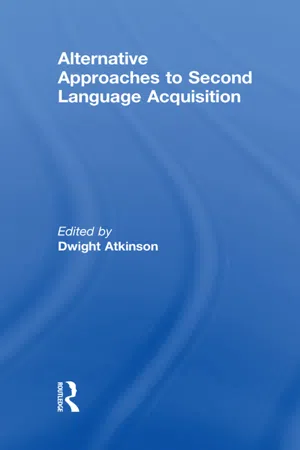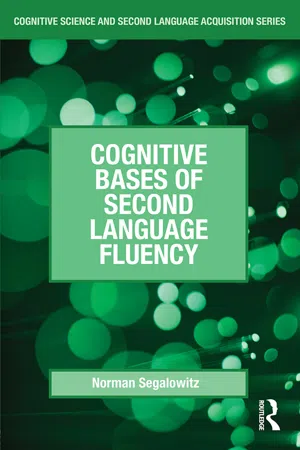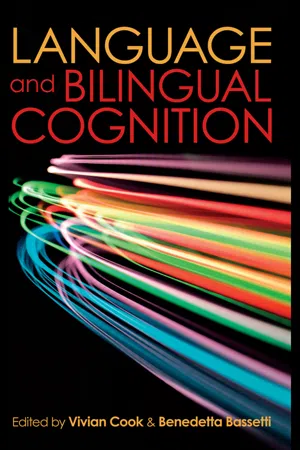Languages & Linguistics
Cognitive Theory
Cognitive theory in the context of languages and linguistics is a psychological approach that focuses on how people acquire, process, and use language. It emphasizes the role of mental processes such as perception, memory, and problem-solving in language learning and use. Cognitive theory also explores how language is represented and organized in the mind.
Written by Perlego with AI-assistance
5 Key excerpts on "Cognitive Theory"
Learn about this page
Index pages curate the most relevant extracts from our library of academic textbooks. They’ve been created using an in-house natural language model (NLM), each adding context and meaning to key research topics.
- eBook - ePub
The Cognitive Sciences
An Interdisciplinary Approach
- Carolyn P. Sobel, Paul Li(Authors)
- 2013(Publication Date)
- SAGE Publications, Inc(Publisher)
8The Role of Linguistics in Cognitive Science
Language AcquisitionFirst-Language AcquisitionStages in First-Language AcquisitionThe Social Aspect of First- Language AcquisitionSecond-Language AcquisitionLanguage DeprivationBilingualismLanguage Acquisition in Abused or Feral ChildrenLanguage Loss (Language Attrition)Language Acquisition in the Deaf and Hearing ImpairedCauses of Languages LossThe Role of Computational LinguisticsAphasiaLanguage and ThoughtComputational Modeling of LanguageL inguists search for the underlying commonalities among languages. Some reconstruct rules of languages no longer spoken, and some focus on the rules of languages currently spoken. The data they describe contribute to our knowledge of the types of rules and principles underlying languages. From these data we can infer much about the functioning of the cognitive processes that produce them. As you read in Part 1, cognitive psychology attempts to understand the processes our minds engage in, the cognitive architecture that makes it all possible. Thus, language is of great interest to those of us in the field of cognitive psychology, concerned as we are with issues of learning and of the representation of knowledge in the brain. The following is a look at some of the areas in cognitive psychology in which language plays a major role and where the overlap with linguistics is plain.LANGUAGE ACQUISITION
First-Language Acquisition
It is helpful to address at this point, because it is far from obvious, the way in which human infants acquire a language (or languages, for many learn more than one in the environment in which they are raised). The word infant - Dwight Atkinson, Dwight Atkinson(Authors)
- 2011(Publication Date)
- Routledge(Publisher)
A cognitive “grammar” therefore consists of a set of symbols and a syntax for arranging them. 3 Relatedly, the psycholinguistic study of language processing has been at the forefront of cognitive science. Following on point 1 above, the implicit theory of language undergirding cognitivism is that language is coded information, to be sent and received via “telementation” (Harris, 1991). Language production and comprehension therefore become, respectively, encoding and decoding processes wherein what are encoded/decoded are units (or at least vehicles) of thought. Likewise, language in this view becomes simply a tool for referring to/encoding the world. 5. Scientism : Mainstream forms of cognitive science model themselves on the (often idealized) basis of the natural sciences and engineering, and especially their favored research methodologies. Other kinds of scientific inquiry, including natural history, some forms of ecology, and the various social science traditions emanating from Dilthey’s (1883/1989) Naturwissenshaft (natural science) versus Geistwissenshaft (science of the spirit or mind, or, in modern terminology, human sciences) distinction are marginalized if not rejected. 6. Substance dualism and functionalism : Starting with Descartes, an unbridgeable divide was posited between mind and everything else—the body and the material and sociocultural environment. In other words, mind was thought to be of a fundamentally different kind, or substance, than physical body and world. One result of substance dualism is functionalism (Clark, 2001)—the idea that cognition can (and, for some influential scholars, must) be understood apart from its concrete physical instantiations. Thus, classical cognitivists (and, more controversially, some connectionists—see Elman, 1998; Reeke & Edelman, 1988) see their object of study as having little if anything directly to do with neurology or biology- eBook - ePub
Second Language Acquisition as a Mode-Switching Process
An Empirical Analysis of Korean Learners of English
- Sooho Song(Author)
- 2017(Publication Date)
- Palgrave Pivot(Publisher)
1999 ) argues that children learn linguistic patterns through constant input from their everyday life and social experiences. They usually start with obtaining lexicons before moving on to abstract and complex structures of grammar. The approach of viewing second language learning based on use is similar to the process of children learning their first language. That is why pragmatic context plays an important role in second language learning.When we argue that a linguistic system is closely connected to human experience, the frequency of instance each language user has had is a prime factor in its structure and operation. Frequency plays a central role because of its capacity to reveal patterns. An interesting component of frequency is how often a particular pattern used results in composting a routinization of cognition on that language system (e.g., Bybee 1988 ; Hainman 1994 ). As a learner continuously repeats use of a pattern along with certain consociated events, they will create “entrenchment ”, what Langacker terms cognitive routinization , which has an influence on the processing of the pattern. This idea that emphasizes the importance of frequency in internalizing certain language units or systems is the main argument in explaining the prominent results of language acquisition.Another path for a functional-based approach is related to a cognitive approach. Cognitive approach focuses on the learning process learners go through to deal with linguistic knowledge. As Mitchell and Myles (2004 ) note, the learner’s job is to operate a complex processing system that deals with linguistic information in similar ways to other kinds of information. In addition, cognitive approaches pay attention to the strategies the learner attempts to use in processing the linguistic knowledge to cope with their incomplete linguistic system. Tomasello (1992 , 2003 ), MacWhinney (1999 ), Tomasello and Brooks (1999 ), and Ellis (1994 - eBook - ePub
- Norman Segalowitz(Author)
- 2010(Publication Date)
- Routledge(Publisher)
Chapter 4 , people have to package the thoughts they want to communicate in a way that meshes with the possibilities afforded by the language—they have to engage in “thinking for speaking,” as Slobin (1996) put it. Language learners need to learn, therefore, how the target language requires them to think for speaking. For this, they have to be able to perceive and exploit the linguistic resources (affordances) available to them at the moment they are needed. What is important for learning, according to the cognitive science perspective, is that exposure to these resources should occur in a context where learners have to use them to fulfill genuinely communicative goals. This is necessary in order to optimize transfer of learning outside the instructional setting.The third idea concerns cognitive fluency , that is, the highly efficient operation of the cognitive processing mechanisms underlying the planning, assembly, and execution of the target L2 utterance. The single elicitation of mental processing activities, however transfer appropriate, will not be sufficient to make them operate efficiently. As discussed in Chapter 4 , there must be a significant amount of consistent repetition of these processes for them to gain significantly in speed and stability (i.e., become more “automatic”; Schneider & Chein, 2003). Thus, a cognitive science perspective would hold that learning activities in the classroom should not only recreate the mental processing involved in communication in the real world (TAP principle), but they should also provide learners with opportunities for systematic repetition in order to activate and reactivate the same set of cognitive processes. It is important to note that what must be repeated is the whole set of mental processes involved in the planning, assembling, and execution of the speech act, and this must occur within genuinely communicative contexts (otherwise, the nature of the underlying cognitive processing could change significantly). Gatbonton discusses how to design instructional tasks that are genuinely communicative and naturally repetitive at the same time (Gatbonton & Segalowitz, 1988, 2005). She argues that the learning activity must be inherently repetitive - eBook - ePub
- Vivian Cook, Benedetta Bassetti, Vivian Cook, Benedetta Bassetti(Authors)
- 2011(Publication Date)
- Psychology Press(Publisher)
The methodology of language teaching that has attracted most attention in the past decade is task-based learning. This sees second language learning as arising from particular tasks that students do in the classroom, i.e., goal-directed communicative exercises; in a sense it reconceptualizes communicative language teaching as tasks rather than as the language-or cognition-based syllabuses of communicative language teaching or the CEFR. To some extent this resembles a version of cognitive psychology that can be labeled ‘cognitive behaviorism’ (Anderson, 1993). It is concerned with language as processing, how the mind handles speech and listening through networks, connections, and the like, and how it learns to do this (Robinson, 2001). However, its remit seems not to extend to cross-linguistic comparison of concepts and categorization, perhaps because these differences are not relevant to its worldview. While task-based learning methodology draws on the research that shows the classroom advantages of teaching organized around tasks (Skehan, 1998), it has not gone on to discuss the cultural differences involved in tasks or to organize teaching around concepts and categories that may differ from one language to another.ALTERNATIVE RELATIONSHIPS OF LINGUISTIC RELATIVITY AND LANGUAGE TEACHING
There are in the main two positions that can be taken about linguistic relativity and language teaching. If we accept that speakers of different languages think differently in some respects, second language teaching has first of all to have some idea what these may be, second to decide which of them may be teachable, and third to devise ways of teaching them. This can rely on the original cross-cultural approach showing differences between speakers of languages in thinking: If Japanese speakers classify some objects by material, and English speakers by shape (Imai & Gentner, 1997), then teaching Japanese to English speakers involves familiarizing them with the Japanese classification of objects and substances, possibly in relation to the grammatical differences that may connect with the categorization difference. So far this does not seem to have occurred in language teaching, apart from nods in the direction of ‘culture’. The issue of what culture means in language teaching is vast and controversial; for more information see Kramsch (1994) and Byram (1994, 1997).




